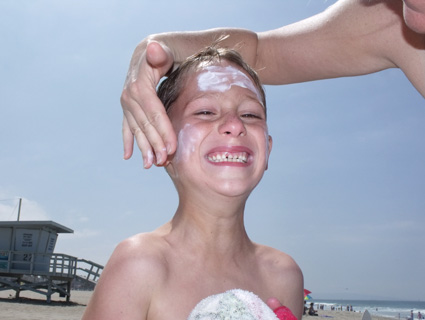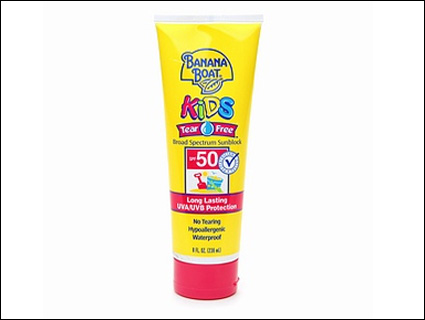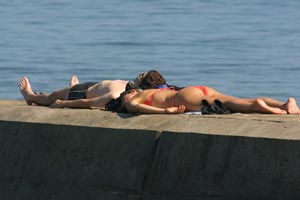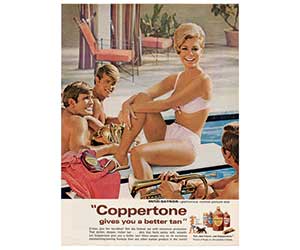
Kirtelisa/Flickr
Ahhh, May. Time to don your sunnies, dig out the sandals, and head for the nearest beach or park for about the next four months. By now, you’ve probably been lectured enough about the perils of sunburn and skin cancer to bring a tube of sunscreen along, too. But while the stuff is important for staying safe from harmful UV rays, there are still enough confusing labels, dangerous ingredients, and misleading SPF designations in so many common products that you may want to opt for a day under the nearest tree instead. Or pay very close attention to exactly what’s in your sunscreen, and how often you’ll want to reapply. So says the Environmental Working Group (EWG), which today released its 2012 Sunscreen Guide.
The guide comes less than a week after the FDA pushed back the compliancy requirement for a news set of guidelines (33 years in the making) meant to urge manufacturers to more clearly label their products and toss out misleading terms like “sweatproof” and “sunblock.” But even the now-delayed FDA guidelines, says EWG, fall short in some important ways.
For starters, the FDA’s new guidelines fail to address the risk of trusting a sunscreen with an SPF higher than 50. For sunscreens that boast SPF 100, for instance, “there’s no evidence they provide additional health benefits,” says David Andrews, a spokesperson for EWG. The higher value “lends to a sense of invincibility, so that people spend more time in the sun longer,” Andrews argues.
What’s worse, says Andrews: “Sunscreen users are actually more likely to get burned.” Wait, what? Those that slather on are more at risk for lobsterdom? “It’s a behavioral thing—because they’re more likely to spend an extended period of time in the sun, and there’s a concern of overexposure.” Mother Jones reported on this false sense of security back in the ’90s.
The FDA is in the process of evaluating a proposed rule to cap SPF at 50, and agency spokeswoman Shelly Burgess agreed flat-out: “We do not have data that demonstrate that sunscreen products with SPF 50 or higher provide any demonstrable health benefit to consumers compared to SPF 50 products.” But she couldn’t give me an estimate of when the proposed rule could reach the end of its review process, which means the cap is in the same place it was a year ago, and high SPF creams still proliferate (and were growing in number in 2010, reported the EWG).
Another reason this matters? SPF values, which reflect how much longer a cream can prevent sunburn than if you were to leave your skin bare, relate to Ultraviolet B (UVB) rays, which cause redness on skin. Ultraviolet A (UVA) rays can also cause skin cancers like melanoma, but leave little immediate visible trace. Someone with a high SPF 80 sunscreen, for instance, may be getting little UVA protection, so they could endure the sun longer without redness, but are exposing their skin to aging, wrinkling, and cancer-causing rays for longer than someone who puts less SPF on and reapplies more often or stays out of the sun.
The FDA’s answer to this is to ensure sunscreens that label themselves as “broad spectrum” block both UVB and UVA rays, and that a higher SPF also reflects more blockage of UVA. The requirement for broad spectrum is good news, and should help consumers select a more protective sunscreen by looking for “broad spectrum” on the label.
But EWG worries that the FDA’s baseline for how much UVA protection a broad spectrum cream must contain isn’t strong enough. “It’s a mathematical model that calculates how much of the UVA spectrum is being blocked compared to UVB,” says Andrews. The FDA’s baseline, which is weaker than Europe’s, “seems to reflect what’s already on the market and not necessarily what’s good for public health.” EWG calculates that only half of the products that passed the FDA’s broad spectrum test would cut it on European markets in regards to UVA.
And some ingredients that protect against UVA work better than others, EWG argues. “An excellent low SPF product might be blocking the same amount of UVA as a higher SPF sunscreen that just meets the baseline for UVA protection,” says Andrews.
EWG’s report assures us that it approves of more beach and sport sunscreens on the market than in years past. But a subsection of the industry may be falling short. Even though more and more lip balms and makeups advertise SPF, EWG only deemed 9 percent of lip balms, 7 percent of makeups, and 9 percent of moisturizers fit for consumers. The culprits? The overuse of oxybenzone, which has been linked to hormone disruption (though the FDA doesn’t have a problem with it), and a form of Vitamin A called retinyl palmitate, which has been linked with skin tumor growth (MoJo‘s Kiera Butler digs into the dangers of these ingredients here and here respectively.) And many of these products, says the advocacy group, don’t offer enough UVA protection. For more guidance on which SPF products to choose, EWG lists its favorite lip balms, makeups, and moisturizers.
All this to say knowing which tube to pack in on your way to the park is tricky business, and without a buyer’s guide, or some background chops on sizing up SPF values and active ingredients, you may want to run for cover and enjoy summer in a shady hammock. This could prove especially important for choosing sunscreens for kids, who are vulnerable to sunburn. The Centers for Disease Control and Prevention cites sunburns early in life as one of the risk factors associated with developing skin cancer. So for stints in the sun with the whole family, here are eleven of the sunscreens EWG warns against, and twenty it highly approves of:
EWG’s Sunscreen Hall of Shame (Kids’ Edition)
In no particular order
1. Banana Boat Quik Blok Sunblock Spray Lotion, SPF 35
Why: Contains 4 percent oxybenzone, a chemical that according to EWG can cause allergic reactions and may disrupt the body’s natural hormones, and is more easily absorbed by kids’ skin (though the FDA maintains that it has no data showing that using a sunscreen with oxybenzone is unsafe).
2. Coppertone Water Babies Sunscreen Lotion, SPF 70+
Why: Contains 6 percent oxybenzone. Also, SPFs higher than 50 have not been proven “to provide any demonstrable health benefit to consumers compared to SPF 50 sunscreen products,” according to the FDA.
3. Banana Boat Baby Tear Free Sunblock Lotion, SPF 50+
4. Arbonne Baby Care Sunscreen Lotion, SPF 30
5. Australian Gold Baby Formula Lotion Suncreen, SPF 50+
Why: All three contain retinyl palmitate, a form of Vitamin A, which may speed the development of skin tumors and lesions.
6. Neutrogena Wet Skin Kids Beach & Pool Sunblock Stick, SPF 70
Why: “EWG recommends avoiding products labeled higher than SPF 50.”
7. CVS Fast Cover Continuous Clear Spray, SPF 50
8. Rite Aid Baby Continuous Spray Sunscreen Lotion, SPF 50
Why: Aerosol spray sunscreens pose inhalation risks, and “make it too easy to miss a spot, leaving bare skin exposed.”
9. GO!screen Natural Mineral PowderBlock Brush-On Suncreen, SPF 30
Why: According to EWG, the zinc oxide particles contained in this bottle could cause lung inflammation if inhaled.
10. Baby Blanket SunBlankie Towelette SPF 45+
Why: The FDA says it doesn’t have data to know if wipes are safe and effective as sunscreens.
11. Lavera Baby & Sun Screen, Medium, SPF 20
Why: Contradictory labeling. While the front of this bottle boasts “effective immediately,” the side panel says: “apply…15 minutes before sun exposure.”
Best Kids’ Beach and Sport Sunscreens
Products that received the highest rating by the EWG, in alphabetical order
1. Adorable Baby, Clear Baby Sunscreen Stick, and Sunscreen, SPF 30
2. All Terrain KidSport Sunscreen Stick Skin Protectant, SPF 28
3. Aubrey Organics Natural Unscented Sensitive Skin/Children Sunscreen, SPF 30+
4. Badger Baby Sunscreen, Chamomile & Calendula, SPF 30+
5. Badger Chamomile Sunscreen, SPF 34
6. BurnOut Kids Physical Sunscreen, SPF 30+
7. COOLA Suncare Baby Unscented Mineral Sunscreen, SPF 50
8. ECO Logical Skin Care Baby All Natural Sunscreen, SPF 30+
9. Elemental Herbs Kids’ Sunscreen, SPF 30
10. Goddess Garden Baby Natural Sunscreen, SPF 30
11. Kiss My Face Kid’s Natural Mineral Sunblock SunStick, Blue, Pink and White, SPF 30
12. Marie Veronique Organics, Kids Safe Screen, SPF 25+
13. Seventh Generation Baby Sunscreen, SPF 30
14. Star Naturals Baby Natural Sunscreen Stick, SPF 25
15. Sunology Natural Sunblock Creme for Kids, SPF 50
16. Suntegrity Skincare Baby Natural Mineral Sunscreen, SPF 30
17. thinkbaby Kids Sunscreen Benefiting Livestrong, SPF 50+
18. TruBaby Water and Play and Everyday Play Mineral Sunscreens, SPF 30+
19. Trukid Sunny Days Sport Sunscreen and Mineral All Natural Sunscreen, SPF 30+
20. UV Natural Baby Sunscreen Lotion, SPF 30+














